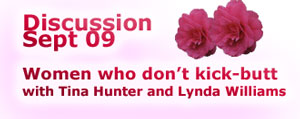 Tina and I will post two original messages each over the next week. One a day. Writers are invited to connect the topics to their own artistic interests. And if you don't write, there's life, reading and media examples to draw on. Today is my second and final post of the discussion (Lynda).
Tina and I will post two original messages each over the next week. One a day. Writers are invited to connect the topics to their own artistic interests. And if you don't write, there's life, reading and media examples to draw on. Today is my second and final post of the discussion (Lynda).Presuming, for the sake of argument, that women are less violent than men (1), do female protagonists in SF and fantasy still need to kick-butt to command an audience? If so, should we dismiss it as an artefact of the action-oriented nature of the genre? After all, the average guy can't kick butt like a hero, either, but it's more fun to identify with a Doc Savage than the wimpy guy next door. Or is there something disturbing about the popularity of Amazon-like females who beat the guys at their own game because it underscores how hard it is for authentic female behaviour to get, and sustain, our attention?
I confess to creating high-testosterone females in my own work (2) and thoroughly enjoyed the thought experiment, so I am not pointing fingers. I am merely curious about the whole phenomenon, because it seems to me, as I mature, that beefing up woman-power in terms of how a heroine can pack a punch is almost like admitting women can’t cut it unless they act like men.
Naturally there are exceptions. I'm partial to the portrayal of Captain Janeway of Star Trek (3) as a strong woman who doesn't enact her force of character in typically male displays of physical dominance, even though she's not afraid to crack hulls when necessary. And while no one could accuse Babylon 5's Delenn (4) of being ineffectual, her prowess is not the mash-and-bash kind.
I still suspect there is something about human nature that makes claiming attention for a woman in SF uphill work, and wonder if this is why I instinctively focused on men for my main characters even though in Amel's case – in particular – I set out to explore the traditionally female problem of making a come-back from victimization and overcoming the pitfalls of being too nice for one's own good.
References
1. Jurik NC & Winn R. “Gender and homicide: a comparison of men and women who kill..” Violence and Victims. 1990 Winter; 5(4):227-42. Retrieved from http://www.ncbi.nlm.nih.gov/pubmed/2098088 on September 10, 2009.
2. Williams, L. “Vrellish Evolutionary Biology”. Science Fiction and Organization Conference. Sept 15, 1999. Retrieved from http://okalrel.org/saga/reference/essays/vrellish.html on September 10, 2009.
3. “Kathryn Janeway”. Wikipedia. Retrieved from http://en.wikipedia.org/wiki/Kathryn_Janeway on September 10, 2009.
4. “Delenn”. Wikipedia. Retrieved from http://en.wikipedia.org/wiki/Delenn
Labels: discussion
We have been telling stories for so many generations with this arch-type of hero that it's hard to create one that doesn't "kick butt" to save the world. Not to mention that for generations this hero was always a man.
But I think, much like the comments proved in the last post, that these things are changing so that readers and writers are able to identify better with the non-traditional hero.
Lynda, do you think that's why you are able to create Sam in your latest book?













